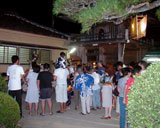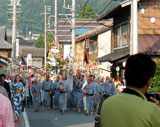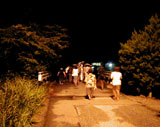“The dancing site moves”
The dancing site moves. The phenomenon which can be called “Moving dancing site” could be widely seen in Bon Dancings nationwide, and it still remains in various localities mainly in traditional type Bon Dancing.*1 These are the most direct manifestations of the dynamism of the place of Bon Dancing, and give strong impression to the people who participate.
*1 We would like to distinguish between “Proceeding while dancing” and the “Dancing site itself moves”. We consider that the former is the matter of the form of the entertainment of the dance and the latter is matter of the dancing site (space).
*2 These processions and marches which accompaniy the move of the dancing sites are called “Michi-yuki”
A type of moving dancing site that can be frequently observed is a type that people visit the houses of Niibon one by one and dance. It could be seen nationwide a decade ago.
Also, in the start and the finish of the dance, there are pattens that they dance at the special points such as family temples of the local inhabitants and the houses of the developpers and influential persons.
Depending on localities, the order of visiting these dancing sites, the composition of the procession, and the contents of the songs and musical accompaniments are determined in details. “The move” is an important factor of Bon Dancing.*
Other examples of moving dancing sites are, such patterns as making a round of visits to the spiritual spots within the localities. In the Yofuke Eisah of Okinawa Prefecture, the dancers visit spiritual spots starting from a small shrine in the garden of the public hall and move into “Uganjo (A place of worship)” and crossroads, and repeat the series of hand dancing.
In the “Ryoushi Kanko Dancing”, people dance in Kainen Temple in the start and in the end of the movement.
*For example, in the Damine Bon Dancing (Aichi Prefecture) performed in the mountains, when the houses of Niibon are plural, they always decide the order of visiting these houses to start from lower houses and move along to higher houses. They call this custom “Nobori Bon (Climbing Bon)”. The opposite is called “Kudari Bon (Descending Bon)”, and it is said to be a taboo.
The reason why the dancing site “move”
Why does the dancing site move? This is the issue which is concerned with the “essense” of the “matsuri (festival)” of Japan.
The moving is an accompaniment to the festivals of Japan. For example, Omikoshi (A portable shrine) is commonly associated with “matsuri (festival)”, and this simply shows the fact that gods “move”.
In the “move” concerning festivals, there are two aspects such as “Kami Mukae (welcoming the god)” which receive the gods and spirits to the place of the festival and “Kami Okuri (sending* off the gods)” which they send off the gods that the people once received, in a gentle and sometimes in a violent manner. The “Mukae (Welcoming)” and “Okuri (Sending off)” of Obon has exactly the same structure with this.*
Generally, if you compare “Kami Mukae” and “Kami Okuri”, “Kami Okuri” is more valued and given higher priority than “Kami Mukae”. It can be said that various events that are concerned with Bon Dancing are public entertainments that are deeply related with especially with this “Kami Okuri”. It can be considered that the reason why the dancing sites move is to drag in the ancestors’ spirits that came to earth in Obon and send them off once again to the afterlife.
*This part has a strong relation with the “Time of Bon Dancing” “Mukae on the August 13th¨Okuri on August 16th”
“Mukae in the early-evening¨Okuri in the first hour of morning”
From the “Moving Dancing Site” to “Fixed Dancing Site”
It can be said that the “Moving Dancing Site” type of Bon Dancing are limited mostly to traditional type of Bon Dancing. And the form of this Moving Dancing Site which could be widely seen all around Japan in the past has rapidly decreased in their numbers after the modern era.
There are several reasons to this. The first is the problem of traffic. “Moving Dancing Site” which many people flood on the streets and the procession of Michiyuki* block off the roads are folk arts that cause big trouble especially in the urban area. Second, as the change of religious folk awareness, the belief of holding a memorial service for the spirits of Niibon, and sending the spirits out of the community gradually died down.
Through these process, it can be considered that many Bon Dancings made shift to “Fixed Dancing Site” type. And along this trend, the form of dancing also placed greater deal of weight to “Wa Odori (Circle Dancing) and thereby became closer to the image of the presently prevalent Bon Dancing.
*Although there are fewer people who participate in Michiyuki, even now, it is a down to earth problem. A mountain village in Aichi Prefecture where there is only one narrow road in the village, people were concerned with Michiyuki and cars passing each other. People said, “If we come across a car, we must ask the car to stop.”, but strangely, they have never met a car in the occasion of Okuri.
The rich spiritual culture of “Okuri”
What will happen at the end after the dancing site of the Moving Dancing Site has moved along one by one ? Actually, the climax was at the moment of the “end”. Let’s restage a common case.
It is close to the first hour of morning since they have already visited many dancing sites. The procession of the people is led by anchorage of new spirits such as “Kiriko Lanterns” which were placed in the dancing sites and move on to a certain place were it falls on to the borderline of community, such as “temples and shrines”, “riversides”, “bridges”, “crossroads”.
And here they perform ceremonies such as burn the “Kiriko Lanterns” (folk custom of the fire), the ascetics recite the mantra, and by doing so every member of the village send out the spirits out of the community. Depending on the localities, there are cases that the last Bon Dancing and Nembutu Dancing is danced in this occasion.
The scene of “Okuri”
Nembutu Dancing in Damine (Shiotsu)
What gives us deep emotion is that there is a common legend that can be almost always heard in various localities after the event of “Okuri”. That is; “You have to go home as soon as possible after Okuri has all finished”, “You must never look back in your way home”, “If you look back, the spirits will come along with you”. These are formal conducts to appeal the separation with the afterlife observed in the occasion when the time of exchange with the afterlife (=Obon) ends.*
These events and courtesies which are perfomed after people have enjoyed Bon Dancing give a quiet sensation to the people who participate in these events and ceremonies. “Moving Bon Dancing”. We cannot refrain from respecting the local people who have created and inherited this dramatic culture.
*We can recall the final scene of the movie “Sen to Chihiro no Kamikakushi (Spirited Away)”. The script of Haku was, “Don’t look back.”



